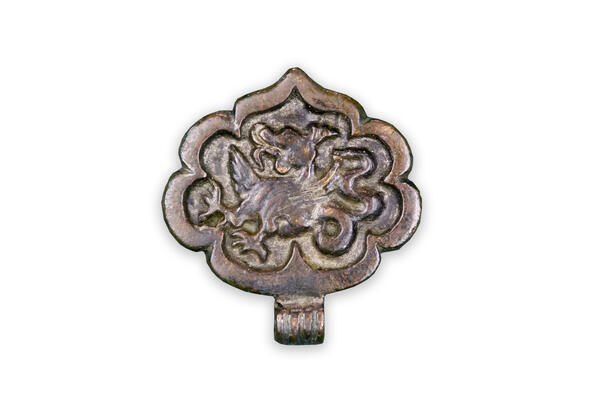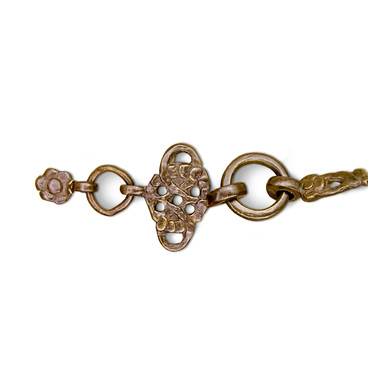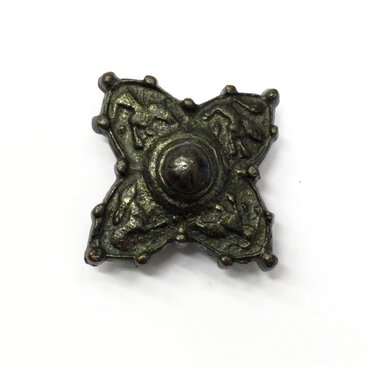The belt plate, presented in the museum exhibition, is a part of the traditional plate-decorated belt. This is the name of the accessory decorated with metal or bone plates. The history of this adornment is about three thousand years old.
For the first time, this type of belt appeared at the end of the 2nd millennium BC among the nomadic cattle-breeding peoples of the Great Steppe in central Eurasia. It was also used far beyond the Great Steppe. During the Middle Ages belts were found in Central Asia and Western Europe, from the Amur River to Austria and Germany. In the 19th — early 20th centuries such belts were common among peoples of Siberia, Central Asia, and Kazakhstan, in cultures of the Caucasus, West Asia, and Eastern Europe. Throughout all these years the belt partly changed but was preserved in some cultures until the middle of the 20th century.
At first, the belt served as an element of armament: a quiver and a cocker, a knife, a dagger, and a sword were attached to it. Archaeologists assume that in real life it could be both military, hunting, and ceremonial at the same time.
The plate from the collection of the Bolgar Museum-Reserve supposedly decorated the ceremonial belt. It was made in the form of a maple leaf. The plate could be attached to the belt using both metal pins on the reverse side and a special loop at the base. In the center of the plate there is a cast image of the mythical creature Zilant: it has a long wriggling body and a tail, bird’s paws, and a huge mouth with a serpent’s sting.
In Volga Bulgaria, the image of Zilant was often placed on metal items. During excavations in Bolgar, a hoarde of silver coins of the late 13th century with the image of this animal was discovered. The dragon could also be found on the coat of arms of the Kazan Khanate and in the elements of heraldry of the Russian Tsar Aleksey Mikhaylovich.
In the mythology of the Tatars and other people, the serpent was originally a peaceful creature and acted as the guardian of the waters. Over time, people started to depict it with wings. They symbolized the process of communication with another world. In the representation of Bolgars, it was possible to get to the sky with the help of wings or birds, and under the ground with the help of reptiles or worms. Zilant was considered a lord of underground waters. With the development of agriculture and the emergence of cities, the serpent gradually turned from a peaceful creature into a complete opposite. It was believed that it was him who caused the drought that destroyed crops, or the rains that led to floods in cities.
For the first time, this type of belt appeared at the end of the 2nd millennium BC among the nomadic cattle-breeding peoples of the Great Steppe in central Eurasia. It was also used far beyond the Great Steppe. During the Middle Ages belts were found in Central Asia and Western Europe, from the Amur River to Austria and Germany. In the 19th — early 20th centuries such belts were common among peoples of Siberia, Central Asia, and Kazakhstan, in cultures of the Caucasus, West Asia, and Eastern Europe. Throughout all these years the belt partly changed but was preserved in some cultures until the middle of the 20th century.
At first, the belt served as an element of armament: a quiver and a cocker, a knife, a dagger, and a sword were attached to it. Archaeologists assume that in real life it could be both military, hunting, and ceremonial at the same time.
The plate from the collection of the Bolgar Museum-Reserve supposedly decorated the ceremonial belt. It was made in the form of a maple leaf. The plate could be attached to the belt using both metal pins on the reverse side and a special loop at the base. In the center of the plate there is a cast image of the mythical creature Zilant: it has a long wriggling body and a tail, bird’s paws, and a huge mouth with a serpent’s sting.
In Volga Bulgaria, the image of Zilant was often placed on metal items. During excavations in Bolgar, a hoarde of silver coins of the late 13th century with the image of this animal was discovered. The dragon could also be found on the coat of arms of the Kazan Khanate and in the elements of heraldry of the Russian Tsar Aleksey Mikhaylovich.
In the mythology of the Tatars and other people, the serpent was originally a peaceful creature and acted as the guardian of the waters. Over time, people started to depict it with wings. They symbolized the process of communication with another world. In the representation of Bolgars, it was possible to get to the sky with the help of wings or birds, and under the ground with the help of reptiles or worms. Zilant was considered a lord of underground waters. With the development of agriculture and the emergence of cities, the serpent gradually turned from a peaceful creature into a complete opposite. It was believed that it was him who caused the drought that destroyed crops, or the rains that led to floods in cities.



